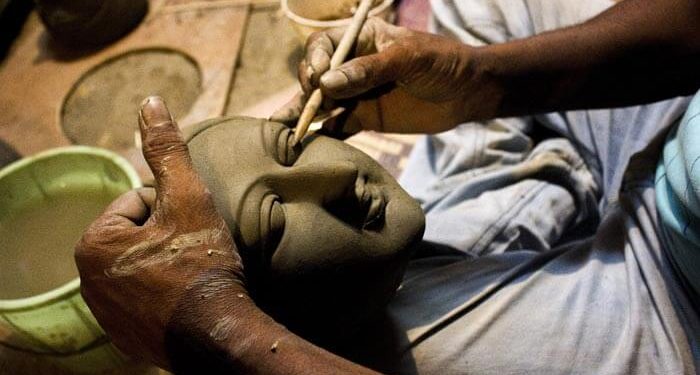Among the rituals prescribed in the religious texts, some have crystal-clear explanations while others are practised without the underlying reason being clear. There is an unexplained practice which requires the use of mud from a sex-workers’ colony or house to make the idol of Goddess Durga. It is said that soil collected from four places is used for making the idol of Devi Durga for Navaratri. Mud from the banks of the Ganges, soil soaked in cow urine, cow dung and soil from a prostitute’s house are required to be used for making the idol of Durga as prescribed in religeous texts. Though the ritual is practiced in a few regions and has been featured in some films including Amar Prem, no one knows how it started. Ahead of Dussehra, Orissa POST asked a few women for their views on the ritual.
“The soil collected from a sex worker’s house is called ‘punya maati’ in Kolkata. The soil is considered holy because it is associated with the virtues of those who visit the place. It is said that when a man visits a prostitute, he leaves behind his purity and virtues on her doorstep. So, the courtyard absorbs the man’s virtues before he enters the house of the woman to satiate his lust. This punya maati is an unavoidable element in the making of the Durga idol,” said Basanti Dash, a homemaker from Odisha, residing in Tollygunj, Kolkata.
“The procedure to collect punya maati is interesting. It is said that the priest visits a brothel to seek mud from a sex-worker’s house for the Durga idol. While she procures the mud, the priest chants some Vedic hymns. The priest has to keep persisting to get the soil even if the woman refuses to part with it,” said Basanti.
“According to some Hindu priests, before the Devi annihilates Mahishasur, the latter tries to outrage her modesty. Angered by this, the Goddess uses all her might to destroy the demon who looks down upon women. Hence, it is believed that using the soil from a prostitute’s house is a way of respecting women who have been humiliated by the society,” said Puja Mishra from Bolangir.
“People might have started the custom to include people who are considered outcasts in the festival. Prostitutes are normally looked down upon by society. So, the ritual can be seen as an attempt to show that the Divine Mother is not just the mother of the masses who are generally good but also the mother of the fallen,” she added.
Manjula Patra from Bhubaneswar, a Sanskrit scholar who has done extensive research on Shakti, said, “Holy texts on Shakti speak about “Kulanganas” or “Navakanyas.” As per the Puranas, there are nine categories of women who are revered as “Striguru” (women gurus):
“Nați kapalika veshya rajaki napitańgana
Brahmaņi śudrakańya ca tatha gopalakanyaka
Malakarasya kańya ca nava kanya prakirtita.”
(Guptasadhana Tantra 1:12)
The nine types of women are nati (dancer/actress), kapalika (skull-bearing tantrics), veshya (prostitute), rajaki (laundry girl), napita (woman barber), Brahmani (Brahmin), Sudra, gopala (milkmaid) and malakara (gardener). Although sex workers are looked down upon by society, holy texts have held them in high esteem, which is reflected in the rituals like the use of mud from a prostitute’s house.”
“It is believed that the path the prostitutes take leads them to a sinful life. Hence, the soil from their house, used for making the Durga idol, purifies their heart and soul. When a prostitute hands over mud to the priest amid the chanting of hymns, their soul gets unburdened of sins because of the vibration caused by the chanting. No woman wants to be a prostitute, she becomes one because of various compulsions. So, there is nothing wrong in the ritual,” said Laxmibai Panigrahi, a retired government employee from Bargarh.
HIMANSHU GURU, OP






































